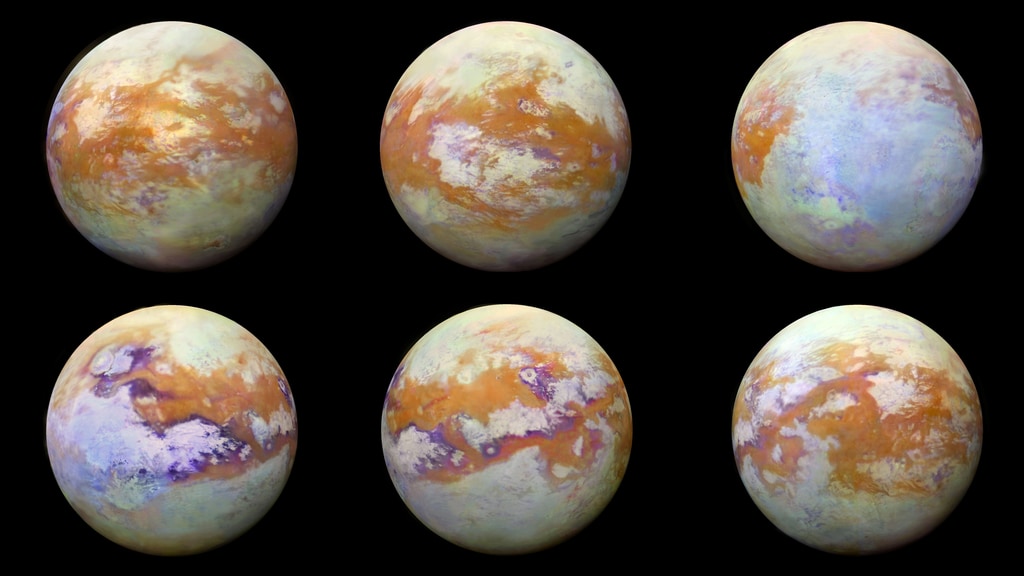Saturn's weird moon Titan looks a bit like Earth, and scientists might finally know why

The surface of Saturn's moon Titan looks a bit like Earth and a new study finally explains why.
Saturn's largest moon Titan features some very Earth-like landscapes: lakes and rivers, labyrinthine canyons, and soft sand dunes. However, these geological formations on Titan are made of entirely different materials. Instead of water, it's liquid methane that flows through rivers, and instead of sand, it's hydrocarbons that blow into dunes.
For years, scientists have been stumped by how these landscapes came to be, given their un-Earth-like composition. But now they've determined a very plausible theory.
Because Titan's sediments are theorized to be made from solid organic compounds, they should be far more fragile than the silicate-based sediments found on Earth. Thus nitrogen wind and liquid methane should wear Titan's sediments down to fine dust, which wouldn't be able to support such varied structures.
Related: Dazzling views show Saturn moon Titan's surface like never before
A team led by Mathieu Lapôtre, an assistant professor of geological sciences at Stanford University, has come up with a potential solution: a combination of sintering, wind, and seasonal change may be able to do the trick on Titan
The researchers studied a type of sediments called the ooids, which can be found on Earth, and which have a similar composition to Titan.
Get the Space.com Newsletter
Breaking space news, the latest updates on rocket launches, skywatching events and more!
Ooids can be found in tropical waters where they form very fine grains. These grains simultaneously accrete material via chemical precipitation and erode in the sea. As a result, they maintain a consistent size.
The researchers think that something similar might be happening on Titan.
"We hypothesized that sintering — which involves neighboring grains fusing together into one piece — could counterbalance abrasion when winds transport the grains," Lapôtre said in a statement.
The team then analyzed atmospheric data from Titan as recorded during the Cassini mission to determine how those sediments could have formed such vastly different geological features observed around the planet.
The researchers discovered that winds were more common around the moon's equator, which created optimal conditions for the development of dunes. Elsewhere, however, the team suspects that lower winds allowed coarser grains to form, and, in turn, more solid sedimentary rock to form. From there, wind could erode the harder rock down into finer sediments, just as what happens on Earth.
Furthermore, because Titan is known to be the only celestial body in our solar system besides Earth to have a seasonal liquid transport cycle, Lapôtre’s team then hypothesized that the movement of liquid methane likely contributes to erosion and sediment development, too.
"We're showing that on Titan — just like on Earth and what used to be the case on Mars — we have an active sedimentary cycle that can explain the latitudinal distribution of landscapes through episodic abrasion and sintering driven by Titan's seasons," Lapôtre said. "It's pretty fascinating to think about how there's this alternative world so far out there, where things are so different, yet so similar."
The hypothesis was published in Geophysical Research Letters on April 1.
Follow Stefanie Waldek on Twitter @StefanieWaldek. Follow us on Twitter @Spacedotcom and on Facebook.
Join our Space Forums to keep talking space on the latest missions, night sky and more! And if you have a news tip, correction or comment, let us know at: community@space.com.

Space.com contributing writer Stefanie Waldek is a self-taught space nerd and aviation geek who is passionate about all things spaceflight and astronomy. With a background in travel and design journalism, as well as a Bachelor of Arts degree from New York University, she specializes in the budding space tourism industry and Earth-based astrotourism. In her free time, you can find her watching rocket launches or looking up at the stars, wondering what is out there. Learn more about her work at www.stefaniewaldek.com.









